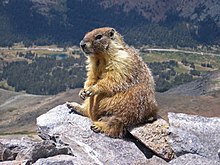Yellow-bellied marmot
| Yellow-bellied marmot | |
|---|---|

| |
| Yellow-bellied marmot in Tuolumne Meadows, Yosemite National Park | |
| Scientific classification | |
| Domain: | Eukaryota |
| Kingdom: | Animalia |
| Phylum: | Chordata |
| Class: | Mammalia |
| Order: | Rodentia |
| Family: | Sciuridae |
| Genus: | Marmota |
| Subgenus: | Marmota (Petromarmota)
|
| Species: | M. flaviventris
|
| Binomial name | |
| Marmota flaviventris | |

| |
| Yellow-bellied Marmot range[1] | |
The yellow-bellied marmot (Marmota flaviventris), also known as the rock chuck, is a large, stout-bodied
Description

Yellow-bellied marmots usually weigh from 1.6–5.2 kg (3 lb 8 oz – 11 lb 7 oz) when fully grown, though males typically weigh more than females.[3] The weight fluctuates quite drastically through the year, with the least measured in early spring and the most measured in early autumn.[4] Adult males typically weigh between 3–5 kg (7–11 lb) and adult females typically weigh between 1.6–4 kg (3+1⁄2–9 lb). They measure from 47–68 cm (18+1⁄2–27 in) in length, have a short tail measuring 13–21 cm (5–8+1⁄2 in) with buffy, reddish and black hairs and hindfoot measuring 7–9 cm (3–3+1⁄2 in).[3]
They have a rather frosty appearance with some of the guard hairs having pale tips with dark bands.
Distribution and habitat

The yellow-bellied marmot lives in southwestern
They are found in valleys, meadows, and foothills, and tend to occupy open areas which are free of vegetation.[1] Their territory is about 2.5 hectares (6 acres) around a number of burrows dug during the summer.[8] They choose to dig burrows under rocks, as it is less likely to be visible to predators. These predators include foxes, dogs, coyotes, wolves, and eagles. Upon seeing a predator, the yellow-bellied marmot whistles to warn the others in the area,[5][a] after which it typically hides in a nearby rock pile until there is no more threat.[8]
Biology
Behavior

Marmots reproduce starting at around two years of age, and may live up to an age of fifteen. They reside in colonies of about ten to twenty individuals.[8] Each male marmot digs a burrow soon after it wakes from hibernation, and starts looking for females to reproduce. By summer, it may have up to four female mates. Litters usually average three to five offspring per female.[9] Only about half of those pups survive and become yearlings.[5] Marmots have a "harem-polygynous" mating system in which the male reproduces with two or three females at the same time.[9] Female offspring tend to stay in the area around their home, while male offspring typically leave when they are yearlings and will defend one or more females.[5]
Yellow-bellied marmots spend about 80% of their lives in their burrows, 60% of which is spent hibernation.[10] They often spend mid-day and night in a burrow as well.[10] These burrows are usually constructed on a slope, such as a hill, mountain, or cliff.[10] The hibernating burrows can be up to 5–7 m (16–23 ft) deep; however, the burrows constructed for daily use are usually only 1 m (3 ft 3 in) deep. Their hibernation period varies on elevation, but it is typically from September to May. Occasionally, they climb trees and other flora, though they are usually terrestrial.[5]
Diet
Yellow-bellied marmots are diurnal, and are less active during the night.[11] They are omnivores, but generally eat a wide variety of plants, as they are generalist herbivores.[12] They mostly feed on grass, grains, leaves, flowers, legumes, bird eggs, and insects.[5] Occasionally, they are also known to eat fruits and bark of fruit trees.[6] In food choice experiments, yellow-bellied marmots are known to reject plants containing defensive compounds.[12] Due to this, they consume flowers of lupines, larkspur, and columbine, but avoid their shoots containing toxic compounds.[13] Their food choice depends upon the fatty acid and protein concentrations, which are well present in cinquefoil, cow-parsnip, and leaves of dandelion, which are also present in their diet.[12] In late summer, however, grasses, forbs, and seeds make up most of their diet.[4] They also like to feed on alfalfa and clover.[4] They drink less water, as their plant diet mostly serves their water requirements.[4]
Status and conservation
Since 1996, it has been listed in the least concern category of the IUCN Red List of Endangered species.[1] As there are no major threats to this species and it is protected in several areas throughout its range, there is not much concern for serious conservation efforts to be put in place.[1]
References
- ^ . Retrieved 12 April 2021.
- OCLC 62265494.
- ^ ISBN 9781607320487.
- ^ ISBN 9781442644830.
- ^ a b c d e f g h "Yellow-bellied Marmot". Washington NatureMapping Program. NatureMapping. Archived from the original on 2017-03-22. Retrieved January 4, 2014.
- ^ ISBN 9780520211995.
- ^ Nash, Matthew (9 May 2021). "Rock chuck takes rare trip to Sequim". Peninsula Daily News.
- ^ a b c Modoc National Forest (N.F.), Sage Steppe Ecosystem Restoration Strategy: Environmental Impact Statement. 2008. p. 113.
- ^ Museum of Zoology. Retrieved 2007-09-12.
- ^ JSTOR 3669865.
- ISBN 9780493416687.
- ^ ISBN 9780801874161.
- ISBN 9780804715348.
Notes
External links
- "Marmota flaviventris". Integrated Taxonomic Information System. Retrieved 18 March 2006.

